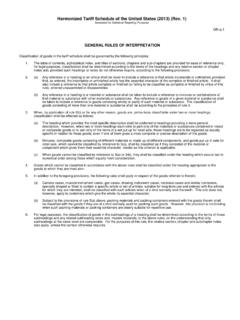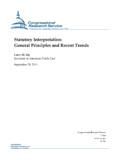Transcription of Q. Discuss the rules of statutary interpretation with the ...
1 Q. Discuss the rules of statutary interpretation with the helpof decided cases. Explain - Literal Rule, Mischief Rule (akaRule in Haydon's case), Golden Rule, Rule of HarmoniousConstruction, Nosciur a sociis, Ejusdemgeneris, Reddendosingul singuis. State the circumstances when these rules areapplied by the interpretation is the process of interpreting and applying legislation to decide is necessary when case involves suble or ambiguous aspects of a , the words of a statute have a plain and straightforward meaning. But in some cases,there may be ambiguity or vagueness in the words of the statute that must be resolved by thejudge. The reason for ambiguity or vagueness of a legislation is the fundamental nature oflanguage. It is not always possible to precisely transformthe intention of the legislature intowritten words. Interpreting a statute to determine whether it applies to a given set of facts oftenboils down to analyzing whether a single word or short phrase covers some element of thefactual situation before the judge.
2 The expansiveness of language necessarily means that therewill often be equally good or equally unconvincing arguments for two competing judge is then forced to resort to documentation of legislative intent, which may also beunhelpful, and then finally to his or her own judgment of what outcome is ultimately fair andlogical under the totality of the find the meanings of statutes, judges usevarious tools and methods of statutory interpretation , including traditional canons of statutoryinterpretation, legislative history, and purpose. In common law jurisdictions, the judiciary mayapply rules of statutory interpretation to legislation enacted by the legislature or to delegatedlegislation such as administrative agency time, various methods of statutory interpretation and construction have fallen in and out offavor. Some of the important rules of statutary interpretation rules Rule(akaPlain Meaning Rule) - It means that statutes are to beinterpreted using the ordinary meaning of the language of the statute unless astatute explicitly defines some of its terms otherwise.
3 In other words, the law mustbe read, word for word, and it should not divert fromits true rule- This rule attempts to determine the legislator's froma 16th century case in the United Kingdom, its main aimis todetermine the "mischief and defect" that the statute in question has set out toremedy, and what ruling would effectively implement this [1960] 2 All rule- It is a compromise between the plain meaning (or literal) rule andthe mischief rule. Like the plain meaning rule, it gives the words of a statute theirplain, ordinary meaning. However, when this may lead to an irrational result thatAcroPDF - A Quality PDF Writer and PDF Converter to create PDF. To remove the line, buy a unlikely to be the legislature's intention, the judge can depart fromthismeaning. In the case of homographs, where a word can have more than onemeaning, the judge can choose the preferred meaning. If the word only has onemeaning, and applying this meaning would lead to a bad decision, the judge canapply a completely different of Harmonious Construction- when there are two provisions in a statute,which are in conflict with each other, they should be interpreted such that effectcan be given to both and the construction which renders either of theminoperativeand useless should not be adopted except in the last immunity State of Bihar (1955) 6 STC 446 (SC).
4 rules aka rules of Language a sociis- When a word is ambiguous, its meaning may be determinedby reference to the rest of the When a list of two or more specific descriptors are followedby more general descriptors, the otherwise wide meaning of the generaldescriptors must be restricted to the same class, if any, of the specific words thatprecede vehicles in "cars,motor bikes,motor powered vehicles" wouldbe interpreted in a limited sense and therefore cannot be interpreted as includingair Singula Singulis- When a list of words has a modifying phrase at theend, the phrase refers only to the last word, , firemen, policemen, and doctorsin a hospital. Here,"in a hospital" only applies to doctors and not to firemen RuleA statues often contains a "definitions" section, which explicitly defines the most importantterms used in that statute. However, some statutes omit a definitions section entirely, or fail todefine a particular term.
5 The literal rule, which is also known as the plain meaning rule, attemptsto guide courts faced with litigation that turns on the meaning of a termnot defined by thestatute, or on that of a word found within a definition itself. According to this rule, when a worddoes not contain any definition in a statute, it must be given its plain, ordinary, and literalmeaning. If the word is clear, it must be applied, even though the intention of the legislature mayhave been different or the result is harsh or undesirable. The literal rule is what the law saysinstead of what the law means. This is the oldest of the rules of construction and is still usedtoday, primarily because judges are not supposed to legislate. As there is always the danger that aparticular interpretation may be the equivalent of making law, some judges prefer to adhere tothe law's literal the words of a Statute are clear, plain or unambiguous, they are reasonably susceptibleto only one meaning, the courts are bound to give effect to that meaning irrespective ofconsequences.
6 Bansal v. State of Rajasthan 2003,SC observed that the intention of thelegislature is primarily to be gathered fromthe language used, which means that attention shouldbe paid to what has been said as also to what has not been said. As a consequence, a constructionwhich requires for its support, addition, substitution, or removal of words or which results inrejection of words as meaningless has to be avoided. This is accordance with the case ofCrawford vs Spooner, 1846, where privy council noted that the courts cannot aid theAcroPDF - A Quality PDF Writer and PDF Converter to create PDF. To remove the line, buy a 's defective phrasing of an Act, they cannot add or mend, and by construction make upfor deficiencies which are left Sur vs Parammindhi Sadhu Khan 1957, J Gajendragadkar says that if thewords used in statute are capable of only one construction then it is not open to the courts toadopt any other hypothetical construction on the ground that such construction is more consistentwith the alleged objective and policy of the Joshi vs MV Shimpi, AIR 1961, relating to Food and Adulteration Act, it wascontented that the act does not apply to butter made fromcurd.
7 However, SC held that the wordbutter in the said act is plain and clear and there is no need to interpret it differently. Butter isbutter whether made frommilk or , when the language of a provision is plain and clear, court cannot enlarge the scope of theprovision by interpretive process. Further, a construction which requires for its support additionof words or which results in rejection of words as meaningless has to be avoidedAdvantages1. Proponents of the plain meaning rule claimthat it prevents courts fromtaking sides inlegislative or political They also point out that ordinary people and lawyers do not have extensive access tosecondary sources and thus depending on the ordinary meaning of the words is the It encourages precision in Opponents of the plain meaning rule claimthat the rule rests on the erroneous assumptionthat words have a fixed meaning. Words are imprecise, leading justices to impose theirown prejudices to determine the meaning of a statute.
8 However, since little else is offeredas an alternative discretion-confining theory, plain meaning Sometimes the use of the literal rule may defeat the intention of Parliament. For instance,in the case ofWhiteley vs Chappel (1868; LR 4 QB 147), the court came to thereluctant conclusion that Whiteley could not be convicted of impersonating "any personentitled to vote" at an election, because the person he impersonated was dead. Using aliteral construction of the relevant statutory provision, the deceased was not "a personentitled to vote." This, surely, could not have been the intention of Parliament. However,the literal rule does not take into account the consequences of a literal interpretation , onlywhether words have a clear meaning that makes sense within that context. If Parliamentdoes not like the literal interpretation , then it must amend the It obliges the courts to fall back on standard common law principles of statutoryinterpretation.
9 Legislation is drawn up with these principles in mind. However, theseprinciples may not be appropriate to constitutional interpretation , which by its naturetends to lay down general principles. It is said that it seems wrong to parcel theConstitution as if it were a Finance - A Quality PDF Writer and PDF Converter to create PDF. To remove the line, buy a Clearly, the literal approach has another disadvantage in that one judge s literalinterpretation might be very different fromanother s. Casey says: What may seemplainto one judge may seemperverse and unreal to another. 5. It ignores the limitations of To place undue emphasis on the literal meaning of the words is to assume an unattainableperfection in Judges have tended excessively to emphasise the literal meaning of statutory provisionswithout giving due weight to their meaning in wider RuleThe Mischief Rule is used by judges in statutory interpretation in order to discover legislature'sintention.
10 It essentially asks the question: By creating an Act of Parliament what was the"mischief" that the previous or existing law did not cover and this act covers. This rule wasdeveloped byLord CokeinSir John Heydon's Case, 1584, where it was stated that there werefour points to be taken into consideration when interpreting a statute:1. What was the common law before the making of the act?2. What was the "mischief or defect" for which the common law did not provide?3. What remedy the parliament hath resolved and appointed to cure the disease of thecommonwealth?4. What is the true reason of the remedy?The application of this rule gives the judge more discretion than the literal and the golden rule asit allows himto effectively decide on Parliament's intent. Legislative intent is determined byexamining secondary sources, such as committee reports, treatises, law review articles andcorresponding statutes. The rule was further illustrated in the case ofSmith v Hughes, 1960,where under the Street Offences Act 1959, it was a crime for prostitutes to "loiter or solicit in thestreet for the purposes of prostitution".





